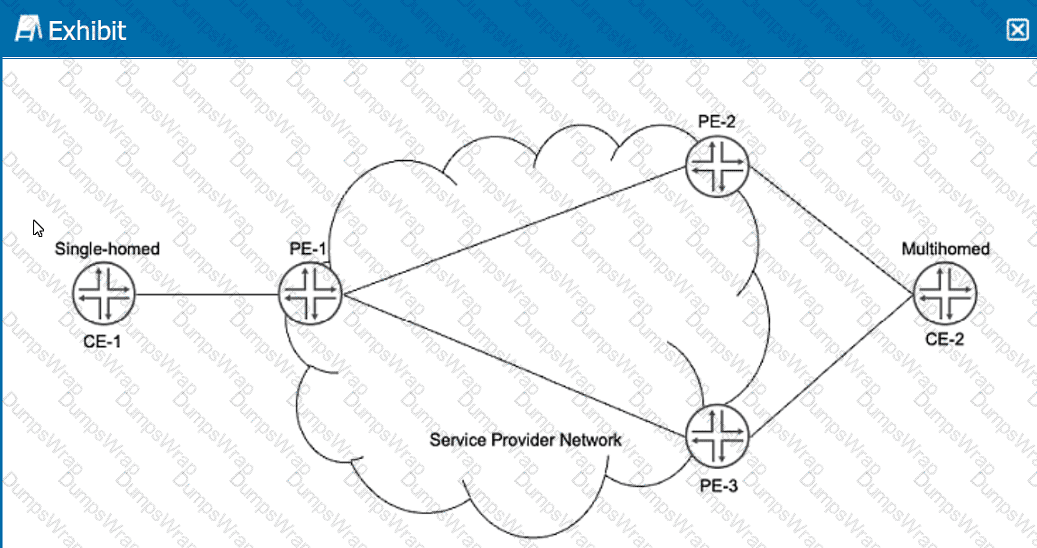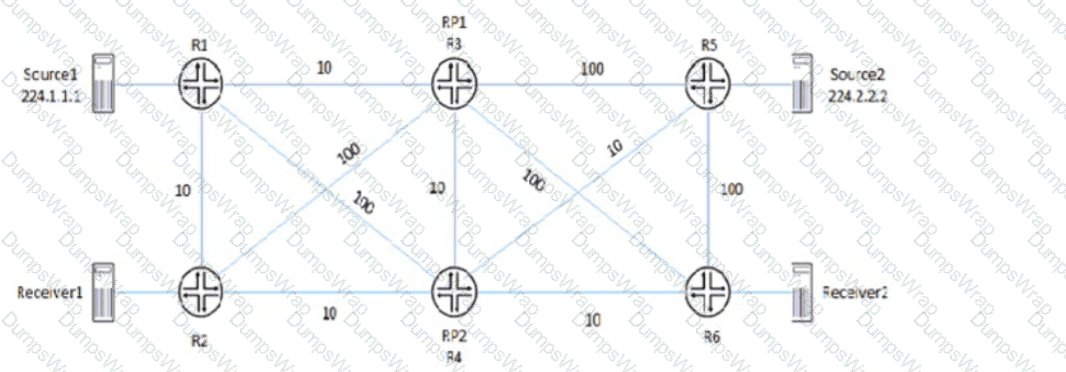Service Provider Professional (JNCIP-SP) Questions and Answers
Exhibit

Referring to the exhibit, you must provide Internet access for VPN-A using CE-1 as the hub CE.
Which two statements are correct in this situation? (Choose two.)
Exhibit

Referring to the exhibit, what do the brackets [ ] in the AS path identify?
You are asked to protect your company's customers from amplification attacks. In this scenario, what is Juniper's recommended protection method?
Exhibit

You are running a service provider network and must transport a customer's IPv6 traffic across your IPv4-based MPLS network using BGP You have already configured mpis ipv6-tunneling on your PE routers.
Which two statements are correct about the BGP configuration in this scenario? (Choose two.)
Which origin code is preferred by BGP?
Exhibit

Referring to the exhibit, which statement is correct?
Which two statements are correct about reflecting inet-vpn unicast prefixes in BGP route reflection? (Choose two.)

Click the Exhibit button.
Referring to the exhibit, you must provide VRF Internet access over a single connection for VPN-A Site 1, which connects to PE-1.
Which two statements are correct in this scenario? (Choose two.)

Click the Exhibit button.
You are troubleshooting an issue for a customer site that uses 10.10.0.0/24 in AS 65224, but you see another AS in the AS path.
Referring to the exhibit, what is the cause of the problem?
Exhibit

Referring to the exhibit, which two statements are correct about the dual route reflectors within a cluster? (Choose two.)
Exhibit

Which two statements about the output shown in the exhibit are correct? (Choose two.)
A packet is received on an interface configured with transmission scheduling. One of the configured queues In this scenario, which two actions will be taken by default on a Junos device? (Choose two.)
Exhibit

Referring to the exhibit, which three statements are correct about route 10 0 0.0/16 when using the default BGP advertisement rules'? (Choose three.)
Which two statements are correct regarding bootstrap messages that are forwarded within a PIM sparse mode domain? (Choose two.)

Click the Exhibit button.
You have an EVI implemented between PE-1, PE-2, and PE-3 to allow communication between CE-1 and CE-2. CE-2 receives unicast traffic from CE-1 on both links to PE-2 and
PE-3. When CE-1 sends broadcast traffic, CE-2 receives it on only one of the multihomed links.
Referring to the exhibit, which EVPN route type enables this behavior?
Which two EVPN route types are used to advertise a multihomed Ethernet segment? (Choose two )
Which two statements about IS-IS are correct? (Choose two.)
Exhibit

Referring to the exhibit, CE-1 is providing NAT services for the hosts at Site 1 and you must provide Internet access for those hosts
Which two statements are correct in this scenario? (Choose two.)
You are responding to an RFP for a new MPLS VPN implementation. The solution must use LDP for signaling and support Layer 2 connectivity without using BGP The solution must be scalable and support multiple VPN connections over a single MPLS LSP The customer wants to maintain all routing for their Private network
In this scenario, which solution do you propose?
Exhibit

R1 and R8 are not receiving each other's routes
Referring to the exhibit, what are three configuration commands that would solve this problem? (Choose three.)
Exhibit

Click the Exhibit button-Referring to the exhibit, which two statements are correct about BGP routes on R3 that are learned from the ISP-A neighbor? (Choose two.)

Click the Exhibit button.
After adding Customer C to your Layer 3 VPN, you must ensure that PE2 is receiving VPN routes for all customers attached to PE1, as shown in the exhibit.
Which operational command displays this information?
You are a network architect for a service provider and want to offer Layer 2 services to your customers You want to use EVPN for Layer 2 services in your existing MPLS network.
Which two statements are correct in this scenario? (Choose two.)
Which two statements are correct about VPLS tunnels? (Choose two.)
You are configuring a Layer 3 VPN between two sites. You are configuring the vrf-target target : 65100:100 statement in your routing instance.
In this scenario, which two statements describe the vrf-target configuration? (Choose two.)
Exhibit

You are asked to exchange routes between R1 and R4 as shown in the exhibit. These two routers use the same AS number Which two steps will accomplish this task? (Choose two.)
Exhibit

Referring to the exhibit, PIM-SM is configured on all routers, and Anycast-RP with Anycast-PIM is used for the discovery mechanism on RP1 and RP2. The interface metric values are shown for the OSPF area.
In this scenario, which two statements are correct about which RP is used? (Choose two.)
Which two statements are correct regarding the PIM DR in a PIM-SM domain? (Choose two.)
Click the Exhibit button.

Referring to the exhibit, which statement is correct?

